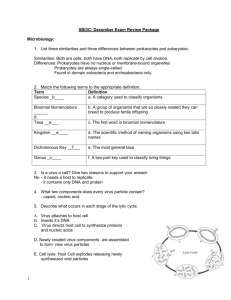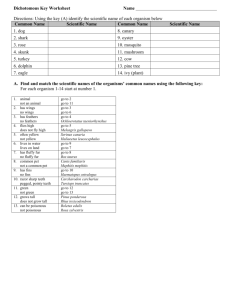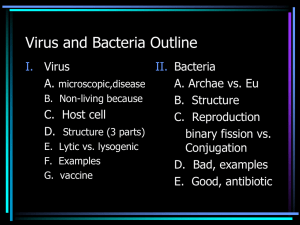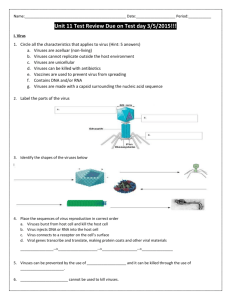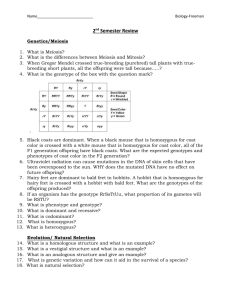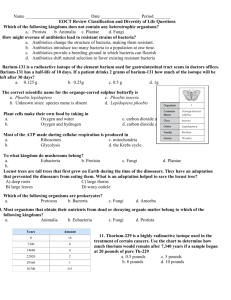SBI3C Microbiology Exam Review Package
advertisement
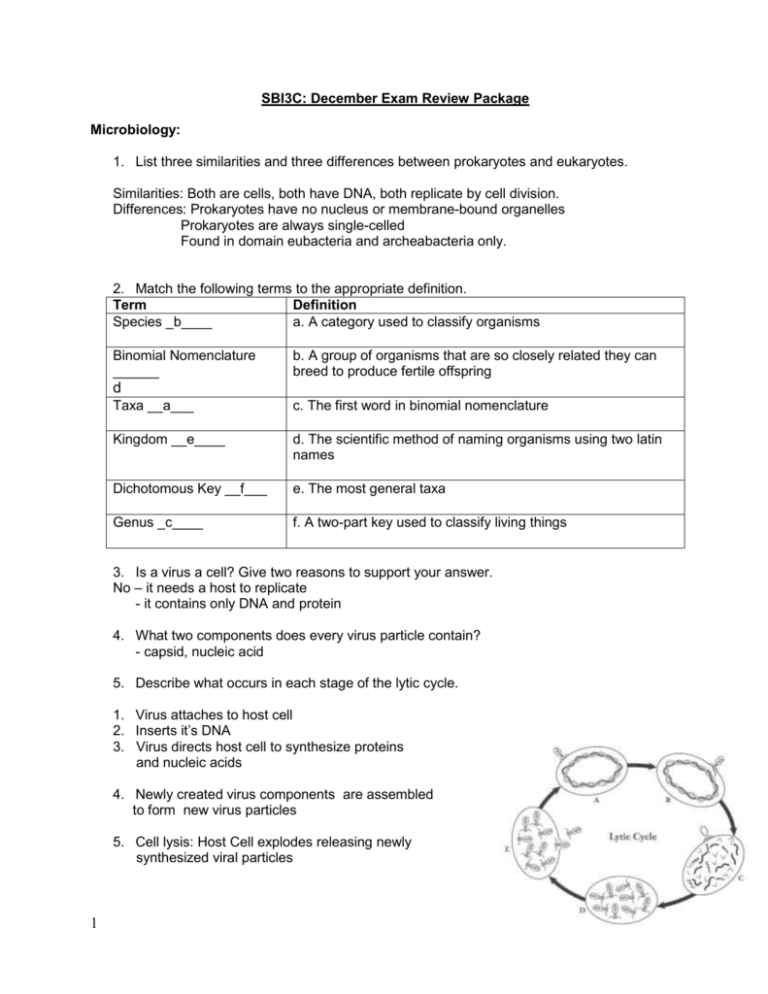
SBI3C: December Exam Review Package Microbiology: 1. List three similarities and three differences between prokaryotes and eukaryotes. Similarities: Both are cells, both have DNA, both replicate by cell division. Differences: Prokaryotes have no nucleus or membrane-bound organelles Prokaryotes are always single-celled Found in domain eubacteria and archeabacteria only. 2. Match the following terms to the appropriate definition. Term Definition Species _b____ a. A category used to classify organisms Binomial Nomenclature ______ b. A group of organisms that are so closely related they can breed to produce fertile offspring d Taxa __a___ c. The first word in binomial nomenclature Kingdom __e____ d. The scientific method of naming organisms using two latin names Dichotomous Key __f___ e. The most general taxa Genus _c____ f. A two-part key used to classify living things 3. Is a virus a cell? Give two reasons to support your answer. No – it needs a host to replicate - it contains only DNA and protein 4. What two components does every virus particle contain? - capsid, nucleic acid 5. Describe what occurs in each stage of the lytic cycle. 1. Virus attaches to host cell 2. Inserts it’s DNA 3. Virus directs host cell to synthesize proteins and nucleic acids 4. Newly created virus components are assembled to form new virus particles 5. Cell lysis: Host Cell explodes releasing newly synthesized viral particles 1 6. Compare and contrast the viral lytic cycle and lysogenic cycle. Similarities Both infect host Use host machinery to replicate Differences Lytic - Causes host cell lysis (death) Lysogenic – Virus integrates into host DNA Lytic – virus escapes from cell Lysogenic – virus can be dormant within host 7. Label the parts of the bacteria cell below: Nucleic acid Cell wall ribosome cilia flagellum 8. List and sketch the three different shapes of bacteria. 2 Coccus bacillus (singular) 9. You are told you have an infection of Streptococcus pyogenes. a. Sketch what you think this bacteria would look like in the box below. b. What genus is this bacteria from? Streptococcus 10. a. The process pictured below is called binary fission. b. Beside each step in the picture below describe what is happening. 11. a. Describe the process of conjugation. 3 Conjugation - Two cells join briefly and one cell donates some DNA (called a plasmid) to the other one. b. Why is it useful for a cell to perform conjugation, and not rely purely on binary fission? Creates more genetic diversity. 12. a. Name and describe one harmful bacteria. Streptococcus – strep throat Clostridium – botulism Bacillus - anthrax Helicopter pylori – causes stomach ulcers b. Name and describe one helpful bacteria. Acetobacter -vinegar production Streptococcus – production of dairy products Bacillus – natural pest killer 13. Why are antibiotics not effective against a viral infection? Antibiotics kill bacteria specifically and viruses are another group entirely. Dichotomous Key Problem Common Name Scientific Name Common Name Scientific Name Meleagris gallopavo 1. dog Canis familiaris 2. shark Carcharodon carcharias 8. canary Haematopus ostralegus 9. oyster 3. rose Rosa sylvestris 10. mosquito 4. skunk Mephitis mephitis 11. mushroom 5. turkey Meleagris gallopavo 12. cow Ochloerotatus taeniorhynchus Boletus edulis Bos taurus Pinus ponderosa 6. dolphin Tursiops truncates 13. pine tree 7. eagle Haliaeetus leucocephalus 14. ivy 4 Rhus toxicodendron Find and match the scientific names of the organisms’ common names using the following key: 1. animal go to 2 not an animal go to 11 2. has wings go to 3 no wings go to 6 3. has feathers go to 4 no feathers Ochloerotatus taeniorhynchus 4. flies high go to 5 does not fly high Meleagris gallopavo 5. often yellow Serinus canaria not yellow Haliaeetus leucocephalus 6. lives in water go to 9 lives on land go to 7 7. has fluffy fur go to 8 no fluffy fur Bos taurus 8. common pet not a common pet Canis familiaris Mephitis mephitis 9. has fins no fins go to 10 Haematopus ostralegus 10. razor sharp teeth pegged, pointy teeth Carcharodon carcharias Tursiops truncates 11. green not green go to 12 go to 13 12. grows tall does not grow tall 13. can be poisonous not poisonous Pinus ponderosa Rhus toxicodendron Boletus edulis Rosa sylvestris 5
